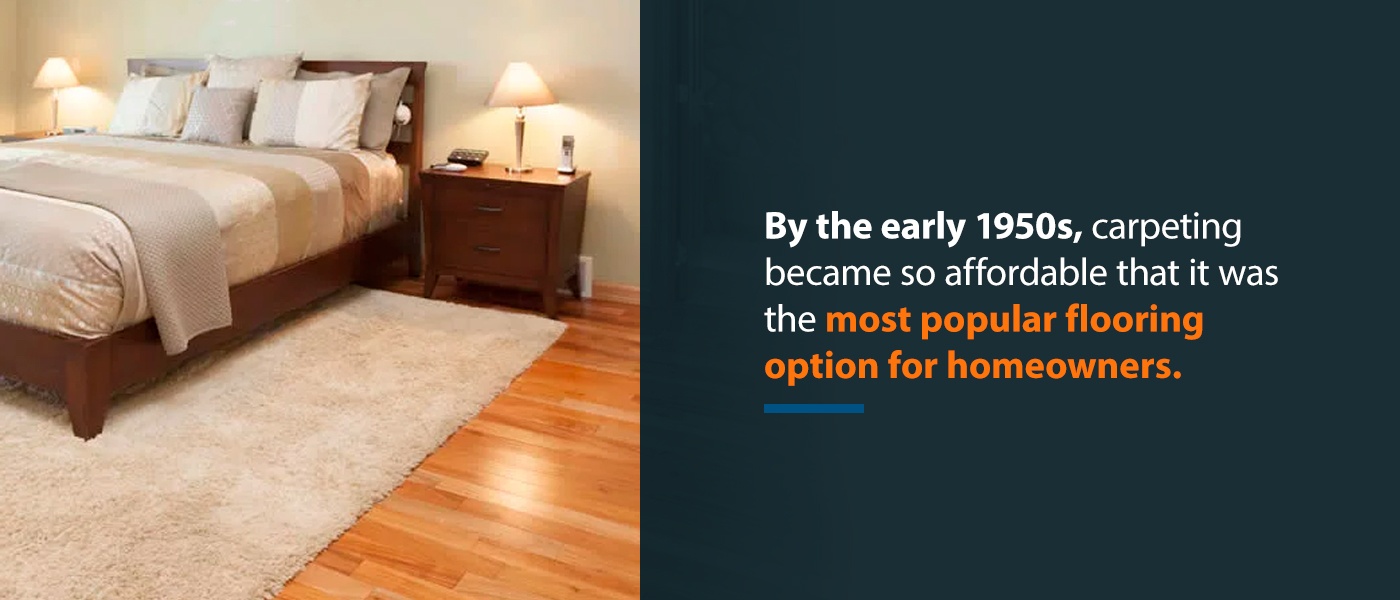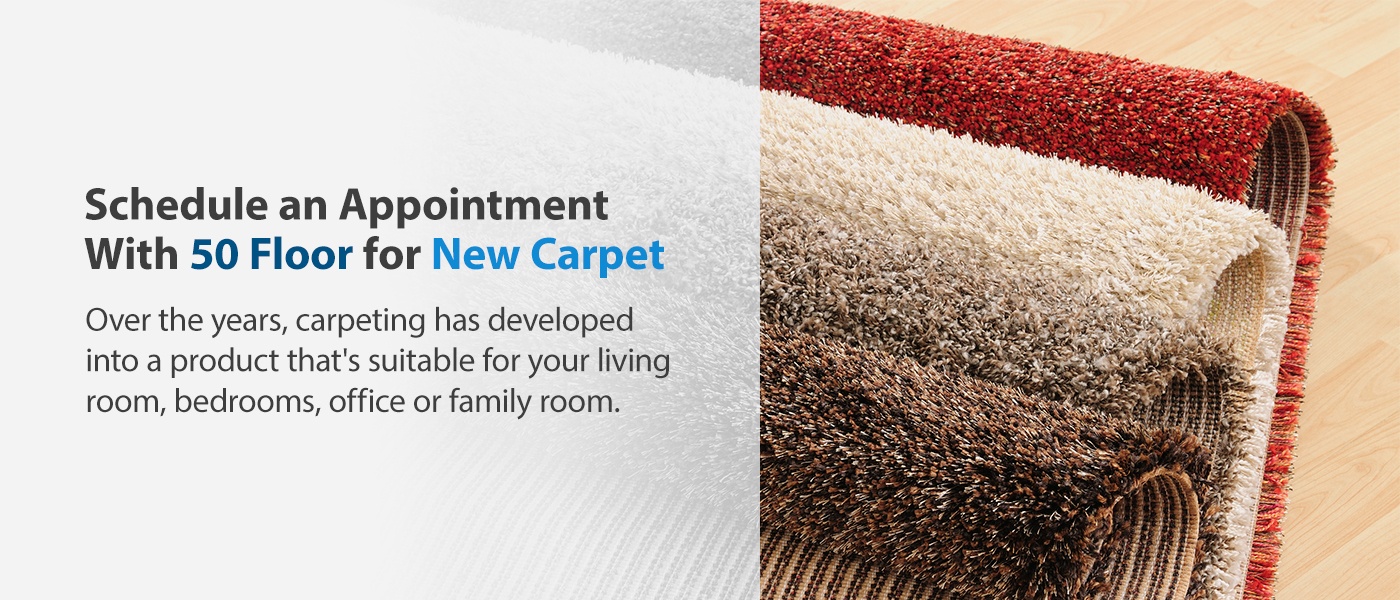

You may have carpeting in your home, or you’re thinking about having it installed. Today, flooring manufacturers use natural and synthetic fibers to make carpeting more affordable, with endless color and pattern options to complement the rooms in your house. But how has carpet transformed over the years? Explore the rich history of carpets to appreciate the flooring available today.
Who Invented Carpet?
It’s not exactly clear who invented carpet, but some of the first carpets came about in the Middle East. They contained sheep wool or goat hair, and their purpose was to make the ground more comfortable for sitting.
By the 1500s, carpet production became popular in Europe due to its influences from the Middle East and Asia. When European settlers colonized the New World, they introduced carpets to America. Most early professionals in the American carpet industry were in Pennsylvania and New England. These artisans produced fine, handwoven rugs, but they struggled to compete with less expensive carpeting imported from Europe and the Middle East. For centuries, carpets were the favored option for American homes because of the low quality of wood flooring.
The Northeast was where most manufacturers produced American carpet until the 1950s when the carpet production industry shifted to the Southeast. New tufted carpet factories opened in the South because of the cheaper labor available and lower overhead. Dalton, Georgia, used to be a textile manufacturing center, and it had a rich tradition of manufacturing tufted bedspreads. As a result, Dalton was ready to transition to tufted carpeting. The carpet and flooring industry flourished in this small town in the 1950s and 1960s.
How Is Carpet Made?
Before the 1950s, most carpets contained woven wool, which was significantly expensive at the time. American homeowners wanted carpeting in their living spaces, but only the wealthy could afford to have it. In 1947, the invention of synthetic fibers such as nylon revolutionized the carpet and flooring industry. These new materials provided a quicker way to manufacture carpeting than woven, woolen ones. By the early 1950s, carpeting became so affordable that it was the most popular flooring option for homeowners.


The fact that the material was more affordable and convenient to produce dropped the price of carpeting dramatically — in some cases in half. The price drop allowed carpeting to be a flooring option that all American families could afford. Tufted carpets originally contained cotton, but manufacturers began developing durable types of nylon to replace the cotton. These nylon carpets had a longer lifespan than cotton ones, but they were still affordable for American working families.
How Carpet Has Advanced Over the Years
Carpeting started as a comfortable spot to sit on the floor. Over time, with new materials and production methods, homeowners today now have many more options for designing their flooring. Here are some of the ways that flooring has transformed over the years.
From Rugs to Wall-to-Wall Carpet
At the end of the 1930s, a tufted wall-to-wall carpet was still a new concept for residential spaces. Instead of taking up a small portion of the room, manufacturers wanted to create a fitted carpet that extended over the entire space. This material also developed into long stair runner strips that fastened to the base stair steps with nails.
Installers then added a tack strip that secured the edges with a seamless finish. Wall-to-wall carpeting has provided homeowners with several unique benefits, such as noise reduction and safety for older adults and children when walking.
New Material Options
Even though the original carpets contained natural wool and cotton, there are now more affordable options for homeowners who have limited budgets. Carpets containing synthetic materials are both faster and less expensive to produce.
Besides natural and synthetic fibers, manufacturers have also created sustainable carpet. Homeowners today are concerned about using recycled and sustainable products to protect the planet’s natural resources. They also want natural options as alternatives to synthetic fibers that release volatile organic compounds (VOCs), creating the new carpet smell.
As you think about what material you want for your carpeting, you may also want to consider whether you want low pile or deep pile carpet. Each type offers a unique texture and has different maintenance requirements. Here are the options we have available for carpeting fibers:
- Nylon: This material is soft and resistant to abrasions and stains. Most residential carpets contain nylon because of its durability and various color options.
- Polyester: If you’re looking for an eco-friendly option, polyester is non-allergenic and contains recycled plastic bottles. It also holds vibrant colors without fading over time.
- Olefin: This material is popular with commercial spaces. However, homeowners also enjoy it because it feels like natural wool but usually withstands more wear and tear.
- Acrylic: As a synthetic alternative to wool, acrylic is soft and resistant to staining, static electricity, moisture and mildew.
- Wool: After thousands of years, carpeting manufacturers still use this material for their residential products. Homeowners appreciate luxurious, long-lasting wool and the soft texture it provides for your flooring.
New Designer Patterns and Colors in Carpet
In the past, solid beige and standard low-plush carpeting were part of the norm. Now, manufacturers can dye carpet fibers with more color options. As a result, you have endless possibilities for flooring colors and textures.
The different patterns and hues available for your carpet give your property a unique appearance and enhances your living space’s aesthetic. As you look for new carpeting, think of which tones and shades would complement the current color palette in your living room, bedroom or family room.
Waterproof and Petproof Carpet
Traditional carpet can be challenging to clean with pets in the house. The natural fibers are typically vulnerable to water damage, mold and mildew growth. Homeowners have opted for other types of flooring to accommodate their messy pets. However, with advances in new carpeting, you can install carpeting even if you have pets. Some homeowners can even put carpeting in their basement.
The carpeting products you can find now are highly resistant to stains, dirt and spilling. Specialized fibers and formulated backing prevent moisture and other debris from entering and soaking through to your subflooring. Instead of having spots all over your carpet, you can easily keep your carpeting clean, even if your pets make a mess on it. If you have pets, talk to a flooring specialist about what carpeting options are available for you.
Schedule an Appointment With 50Floor for New Carpet
Over the years, carpeting has developed into a product that’s suitable for your living room, bedrooms, office or family room. Schedule an in-home appointment with us to choose new carpet for your home. We’ll come to your house and provide samples of all our inventory so you can see how each one will look with your current decor and wall color. For more information about our products and services, you can also call us at 1-877-50-FLOOR.




